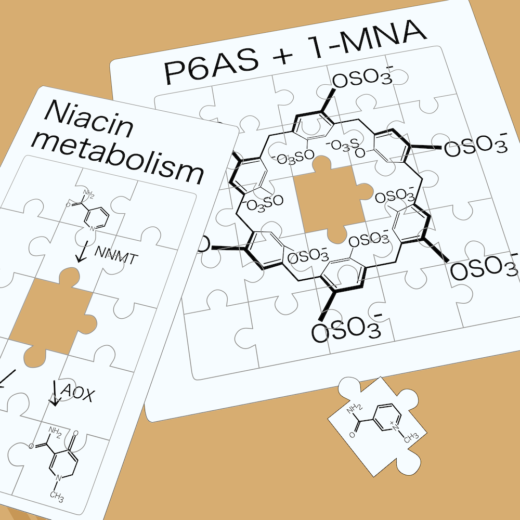High sensitivity high throughput biosensor measures metabolite levels that indicate disease
Researchers at the Nano Life Science Institute (WPI-NanoLSI), Kanazawa University, develop a biosensor that improves sensitivity to 1-methylnicotinamide (1-MNA) in urine by orders of magnitude without the need for sample purification.
Metabolites are a common indicator of disease. In particular 1-MNA levels are increased by cancer, liver disease, obesity and metabolic disease. At present mass spectrometry and nuclear magnetic resonance measurements are commonly used to measure quantities of metabolites in samples but they are expensive and complicated limiting their widespread use. Instead Masaya Ueno, Tomoki Ogoshi and Atsushi Hirao at Kanazawa WPI-NanoLSI use a type of pillararene molecule (Figs. 1 and 2) as a biosensor, getting around the need for high purification of other 1-MNA biosensing molecules while improving sensitivity and specificity.
1-MNA is produced in the body through the methylation of nicotinamide (Nam) by nicotinamide N-methyltransferase (NNMT) during the metabolism of the vitamin B3 vitamer niacin. As such it provides a measure of NNMT activity, which is elevated in some cancers. There is evidence that 1-MNA levels correlate with the how aggressive the tumour is and suppressing the gene for NNMT diminished certain behavioral symptoms of disease. As such the researchers explain in their report “monitoring the NNMT expression and activity in patients by quantification of 1-MNA is important for elucidating and diagnosing their pathology.”
Previously they had demonstrated some potential for the molecule pillar[6]arene functionalized with 12 carboxylate anions (P6AC) as a 1-MNA sensor, since it binds to 1-MNA and inhibits fluorescence due to photo-induced electron transfer. However extensive sample purification was needed and even then, although the millimolar concentrations in murine urine could be detected, the P6AC biosensor lacked the sensitivity to detect the micromolar concentrations found in culture supernatants of human cancer cells.
To find a biosensor with better sensitivity, the researchers investigated the binding between 1-MNA and pillar[6]arene functionalized with sulfonate groups (P6AS). They found that the binding affinity was 700 times greater than for P6AC, leading to a biosensor with sub micromolar sensitivity, even in unpurified human urine, although detection of the higher concentrations in mouse murine was better. However the researchers noted that detection in human serum was not possible due to the higher levels of autofluorescence.
By comparison the detection sensitivity possible with mass spectrometry is nanomolar but the throughput is much lower. The researchers suggest that the high throughput of the P6AS biosensor could make it suitable for screening 1000s of potential NNMT inhibitors, which may help towards a treatment for diseases like liver disease and cancer.
The researchers explain the higher sensitivity thanks to the stronger acidity of sulfonate groups compared to carboxylate groups. They conclude their report of the work, “Further improvement of our strategy will contribute to high-throughput screening of NNMT inhibitors, diagnosis of liver diseases, and imaging of human cancer cells in vivo.”

Fig. 1 Chemical structure of Pillar[n]arene and 1-methylnicotinamide (1-MNA). Copyright 2024 Masaya Ueno

Fig. 2 Pillar[6]arene with 12 sulfonate groups (P6AS) specifically forms complexes with 1-methylnicotinamide (1-MNA)-a niacin metabolite-and works as a biosensor even in unpurified biological samples. Copyright 2024 Masaya Ueno
Glossary
Pillar[n]arenes
The pillar[n]arenes take their names from their pillar shapes and macrocyclic structures. The researchers were prompted to investigate the potential of P[6]AS as a 1-MNA detector following previous work by another group demonstrating the high binding affinity of P[n]AS for ammonium ions.
Binding affinity
The binding affinity refers to the strength of bond between the ligands on the protein and the candidate molecule, typically through intermolecular interactions such as ionic or hydrogen bonidng or van der waals forces. The is a higher binding affinity when the attractive forces are higher.
Mass spectrometry
Mass spectrometers identify molecules based on their mass. The molecule is ionized and then accelerated through a field. The trajectory the molecule takes gives an indication of the charge mass ratio of the ion.
Article
- Title
- A supramolecular biosensor for rapid and high-throughput quantification of a disease-associated niacin metabolite
- Author
- Masaya Ueno, Hiroki Sugiyama, Feng Li, Tatsuya Nishimura, Hiroshi Arakawa, Xi Chen, Xiaoxiao Cheng, Shinji Takeuchi, Yumie Takeshita, Toshinari Takamura, Sakae Miyagi, Tadashi Toyama, Tomoyoshi Soga, Yusuke Masuo, Yukio Kato, Hiroyuki Nakamura, Hiromasa Tsujiguchi, Akinori Hara, Atsushi Tajima, Moeko Noguchi-Shinohara, Kenjiro Ono, Kenta Kurayoshi, Masahiko Kobayashi, Yuko Tadokoro, Atsuko Kasahara, Mahmoud I. Shoulkamy, Katsuhiro Maeda, Tomoki Ogoshi, Atsushi Hirao
- Journal
- Analytical Chemistry
- Publication date
- Aug 25, 2024
- DOI
- 10.1021/acs.analchem.4c02653
- URL
- https://pubs.acs.org/doi/10.1021/acs.analchem.4c02653

